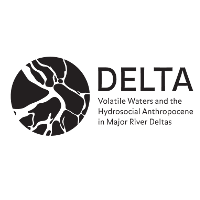Living with water: changes, adaptation and continuity along the Ayeyarwady river delta
Deltas are landscapes of movement – moving waters, moving sediments, moving fields, moving soils, moving fish populations – made use of by mobile people, subsistence farmers, members of fishing communities, migrant workers, artisans. Its unsolid surface, where it is difficult to reach terra firma rapidly challenge human endeavours to build permanent places. Deltas respond to variations in both sea level and weather, to changes in energy and sediment supply, changes in the water table, and to local precipitation patterns. These variations have implications for the lives of delta dwellers who have to deal with the shifting landforms and water bodies.
The Ayeyarwady delta is a low-lying fertile plain that provides favourable conditions for agricultural activities, supplying until 65 percent of the total rice production of Myanmar. The region is home to millions of subsistence farmers whose life move in time with the cycles of rice production, fishing and other livelihood activities, in a complex and rich environment where fresh and saline waters collide with each other’s. Agricultural lands in the delta have been essential to ensure stable paddy supply for domestic demand and surplus for export. Yet, this favourable ground can at the same time be hazardous and source of uncertainties: rivers may flood, sea-level rise affects tidal movements, salt intrusion moves upstream, storm surges appear and penetrate inland threatening life and arable land. Cyclone Nargis which hit the Ayeyarwady region in May 2008 causing disastrous effects on life, health and the environment was a dramatic expression of the vulnerability of delta population. Post-disaster programs and flow of development aid following the process of democratisation of Myanmar, prompted considerable transformation of the delta region which has been widely acknowledged as vulnerable and/or at risk in the face of future climate change. While the effects of weather variations and other fluctuations have been largely noticed in the case of the Ayeyarwady, there has been little documentation of what dwelling actually is and how it has been maintained over the years. Compared with other river deltas in South and Southeast Asia, the Ayeyarwady delta is relatively underdeveloped and its river remains far from control. In this setting it is the objective of this PhD project to explore how delta inhabitants face, manage and adapt to changes in land and water conditions. Although the volatility and uncertainty of living in the delta have been ascribed to the effects of global environmental change, this project will look at the ways global processes are locally manifested and how are water variations sensed and dealt with by differently positioned people in the delta. In a period where Myanmar is experiencing considerable transformations, this PhD also shares a practical objective in documenting lived experiences, local ways of knowing and dwelling in the delta.
This research will combine environmental anthropology with advancements in political ecology and science and technology studies to investigate lived experiences of environmental changes and aims to contribute to literature on human-environment relationships, water management and resilience studies.
